Outineau
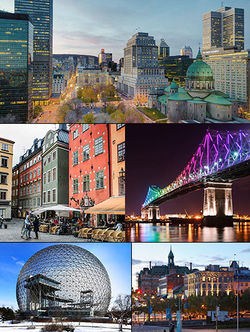
| |
| Counterclockwise from top: Place de la Confédération, Pont Louis-Desjardins lighted for Gay Pride celebrations, Place de la Navigation, La Biosphère, rue Anchois in Ville-Baptiste. | |
| Province Country |
|
| Population City Metro area |
7,284,008 14,120,500 (2nd) |
| Time zone | Kelssek Coastal Time (+8 UTC; +9 UTC in summer) |
| Area codes | 020, 541 575, 309, 191 (metro) |
Outineau is the provincial capital and most populous city of Beaulac, renowned for its vibrant cultural scene and hosting a wide variety of major international sports and cultural events. An important global city, Outineau has a diverse and multicultural population with French being the most widely-spoken language in the city. As of the 2018 census, Outineau has a population of over 7 million people and its metropolitan area (known as Région Ôshaga or the Oshaga region) had 14.1 million inhabitants making it the second-most populous urban area in Kelssek.
A major economic centre, the main employers in the city are the sectors of financial services, education, the provincial government, aerospace, and media. Tourism and entertainment are important economic sectors; the city is Kelssek's most-visited foreign tourist destination. Outineau is also a major hub for the aerospace and transportation technology industry; it is the location of the head office and several major production facilities of Celestar, which is the largest manufacturing firm in Kelssek. With eight universities in the city and metropolitan area, Outineau is an international centre for higher education, research and innovation with Kelssek's largest concentration of post-secondary students.
In the commercial sector, the city is the headquarters of the Société des Caisses, the credit union network which is the province's largest financial institution, and is Kelssek's second-largest centre for commercial banking after Kirkenes in addition to being the location of Kelssek's national commodities and securities exchanges. Pharmaceuticals, media, film and television production, oil refining, and foods are the city's other important industries. Software, video game, and visual effects production are also important sectors, with large tech campuses in the outlying cities of Longevin and Saint-André, but some larger companies like UxTor and Studios JeuxJoo having located themselves downtown as well.
Outineau was the host city of the 5th Summer Olympics and the final of World Cup 46.
Contents
History
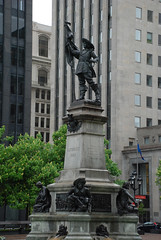
|
| Statue of Chartris at Place d'Armes. |
Outineau is thought to have been first settled in the late 14th century. During the Guedian Kingdom it was the home of the Lord of Paulanice (who was colloquially referred to as the Prince of Beaulac, although the name Beaulac was not formally used at the time) and the capital of the principality. During this period, fur trapping, maple syrup, and timber from the forests surrounding the city became its major industries and source of wealth. The city grew into a transportation and economic hub from its strategic location controlling access between Lake Claire and water access to the interior's farmland.
Outineau was the home of the folk hero Louis Chartris des Pins. Chartris was a rouge knight who turned against the Prince Regent James VII, who he felt was mistreating the peasants. James VII had also declared the rightful Prince insane and imprisoned him in his chambers. Chartris led a failed rebellion to free the Prince and was captured and hanged by the Prince Regent's forces in 1696. Stories about Chartris, which play on his heroism and swordsmanship, are an important historical part of francophone Kelssek culture, perhaps best shown in the book L'épée de Chartris (in English, The Sword of Chartris) which is thought to have originated in the late 1700s.
Outineau was a hub of revolutionary activity in the late 19th century as momentum to overthrow the monarchy grew. Louis Desjardins was among several influential leaders who helped to grow the movement in Outineau and in Beaulac. The Movement for a Socialist Republic, one of the critical groups in the revolution, was founded in Outineau and army regiments in the city were among the first to turn to the cause of the Revolution. Following the 1889 revolution and overthrow of the monarchy, Outineau became a centre of banking and commerce. Outineau's population reached the one million mark in 1910, helped by a huge influx of immigration. While the cheap labour source proved an economic boon, the period was also marked by deteriorating sanitary conditions and widening inequality. Housing and education spending as well as infrastructure upgrades brought by the government of Kieran Pearson helped relieve these problems and Outineau began to grow into a city more recognisable to the people of today.
For most of its history, Outineau was the largest city in Kelssek and the economic and business centre of the nation; it was overtaken in this regard by Kirkenes in the early 1980s. However, Outineau remains a very important commercial centre and Kelssek's undisputed hub of arts and culture as well as its most vibrant and lively city.
Geography and climate
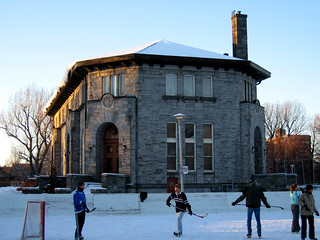
|
| During the winter, the city maintains ice rinks in public parks for skating and hockey. |
The city and its surrounds is located on a group of islands at the delta of the Maisonneuve river where it empties into Lake Claire. It is the major port on the lake and the natural harbour which is the furthest inland, which accounted for its strategic geographic location as the inlet into the lake is the point at which the Haligonia river system is no longer navigable for ocean-going vessels. The Port of Outineau, today located on the south-western edge of the city centre, is a major transshipment point where agricultural products and natural resources produced in interior and western Kelssek arrive in cargo trains and are loaded onto container ships, while imported goods are offloaded and taken in the other direction.
Outineau proper occupies the southeastern edge of the largest of the islands, known as the Île d'Outineau. The administrative area governed by Ville d'Outineau borders the cities (villes) of Saint-André, Dollard-des-Ormeaux, Dorval, and Longevin. Two largely English-speaking enclaves are entirely within the territory of Outineau, the cities of Dorchester. Although much smaller than other municipalities they have been able to retain their separate municipal governments for historical and political reasons. All of the 14 municipalities in the Greater Outineau census metropolitan area are also part of the Communauté urbaine d'Outineau, which serves as a meeting and coordinating body for the municipal governments, allowing them to pool resources and services as well as plan for the region as a whole.
In Statistics Kelssek's definition of the area, the census metropolitan area is officially known as the Osheaga region (région Ôshaga) named after the historic village which is the oldest known human settlement in the area and which is thought to have been located partly on the Desjardins University campus and the northern part of the financial district.
Experiencing a humid continental climate, Outineau is known for its harsh winters, marked by heavy snowfall and low temperatures with average winter highs ranging from -2 to -6°C. Average winter snowfall is 355cm, while total annual precipitation is around 920mm. Warm and humid weather prevails in the summer, with average summer highs at 20 to 26°C. Spring and autumn brings pleasant and mild weather, but heat waves and cold snaps are not uncommon.
City life
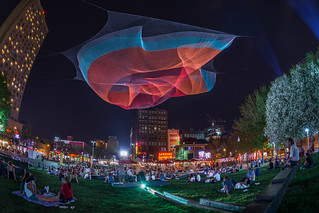
|
| Enjoying an evening out at Place Amélie-Poulain. (Flickr/hm.pix) |
The city's dynamic cultural scene is part of daily life in Outineau. The Quartier Latin, especially, is a neighborhood crowded of cafés animated by literary and musical activity. Outineau is also a haven for the classical arts; which centre around the Palais des Arts. The Palace is a sprawling arts complex with several halls for musical, dance, and theatrical performance of all kinds and is home to Les grands ballets Kelssekiens, Opéra d'Outineau, and the Orchestre symphonique d'Outineau. The base of the world-renowned circus troupe Cirque de Lune is located at Vieux-Port. Among the most-visited neighbourhoods is the district of La Petite-Ariddie (Little Ariddia), which is the historical centre of the Ariddian diaspora in Kelssek and where all the best vegetarian restaurants are.
Outineau has long been known for its well-established restaurant scene and is hailed as a premier foodie destination with an array of famed chefs and restaurants. Some of these chefs can be found in the mornings examining the produce at the Marché du Nord or the Marché du Havre, the latter being the offload point for fishing trawlers coming in from the coast. A wide range of cuisines are represented in the multicultural city. Its most well-known local foods, however, are rather humble one - Outineau smoked meat (known as viande fumée d'Outineau or simply viande fumée), bagels, and poutine. Poutine, a dish of fries, cheese curds and gravy, actually originates from rural regions of Beaulac but is nonetheless well-established in Outineau, and indeed, throughout Kelssek; it is common pub fare in other parts of the country. Another well-known speciality is "poule mouillée", chicken barbecued with a heady mix of spices and hot sauce.
Attractions and tourism
The city of Outineau is the most-visited tourist destination in Kelssek. The city's nightlife and joie de vivre are often cited as its main attractions, and perhaps is the strongest downtown and in the Plateau-Nord and Saint-Laurent districts, but more specific sights include Ville-Baptiste, the city's historic district and location of well-known landmarks such as the Marché Bounsecasseil, Place d'Armes and the statue of Louis Chartris, the Basilique Notre-Dame, Champ d'Avril, and Palais National, the historic building which formerly housed the province's legislature.

|
| Poutine is a characteristically Beaulacois dish, and can be ordered with a variety of toppings. |
Casino Outineau and the Biosphère d'Outineau, an iconic spherical structure housing a museum of hydrological ecosystems, are located on the Île Saint-Hélène. The Musée nationale d'aviation (National Museum of Flight) is also a popular attraction located on the outskirts of the city which is a major draw for visitors with families. Artistic institutions include the Musée des Beaux-Arts and the Musée d'art contemporain d'Outineau, two of Kelssek's largest art museums, while others may also prefer to see the famously avant-garde exhibits of the Musée d'art moderne.
Another city landmark is the Hôtel du Parlement, an abstract-modernist style building completed in 1994 which houses the Assemblée nationale du Beaulac, located in the Ahuntsic district on the grounds of the Parc de l'Assemblée, which contains many statues, busts, and other monuments to prominent citizens of Beaulac.
Districts and neighbourhoods
The city's historical west-east division between English and French speakers persists somewhat today, with the districts of Westmarch and Dorchester to the west of the downtown core still largely upper-class, anglophone enclaves, offering tea shops, decent chippys, and very fancy restaurants. The eastern and northern francophone suburbs like Côte-des-Neiges and Maisonneuve tend to be more working-class, diverse, and a good place to find excellent ethnic foods, while Outremont on the northern side of Mont-Phare is a middle-class francophone area with a large student population, given its location adjacent to the Université d'Outineau campus. The area immediately east of the Desjardins University campus, meanwhile, is known as the "Desjardins Ghetto" because almost all its residents are employees, faculty, or students at that university.
The city's downtown business district becomes all about pleasure at night. Rue Peel is lined with Sorthern pubs and restaurants, while strip clubs and seedier entertainment venues can be found along Nouvelle-Cambrie and Sainte-Catherine streets. Although Kirkenes is perceived to hold the edge in glamorous nightclubs, Outineau offers its share of glitzy dance floors mostly in the southern Plateau and around Place Beaumont downtown. Ville-Baptiste, the city's historical district, is the place to find cafés, art galleries, and trendy restaurants, as well as tourists wandering around in a daze pointing cameras seemingly at random and asking how to get over to "that big sphere thing" (La Biosphère).
Coffee houses, music venues, dive bars, brewpubs, and good food also are to be found on the Plateau-Mont-Phare. The cool kids consider the Plateau to have become gentrified and infested with bobos (bourgeois bohemians/champagne socialists), and so chez hipsters has in recent years moved further north to Mile-End, Parc-Extension ("Parc-Ex"), and southeast to Verdun. Lachaîne-Nord, Côte-Couche-Soleil, and Sainte-Marie are also frequently-visited neighbourhoods for their architecture, bistros, food markets, and boutiques.
Several large parks are found within the city and along the shores of the Claire river. The largest is Parc du Mont-Phare at 9.7 square kilometres, which covers the 249-metre hill at the centre of the city, and offers a lookout point at the summit overlooking the city centre. Another major park is Parc Rivulet, where the artificial lake is operated as a skating rink in winter and features on many postcards.
Arts and culture
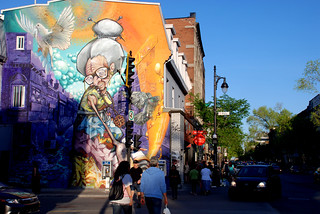
|
| Outineau's streets and alleys feature a profusion of graffiti murals and street art. |
Outineau is renowed as a city of vibrant cultural life, day and night. It hosts a multitude of festivals, like the Festival of Lights fireworks competition, the Outineau Comedy Festival, the Outineau International Jazz Festival, the Outineau Fringe, and holds the country's largest Gay Pride Parade. Other significant annual music events include Francofolies d'Outineau, Outineau Islands Rockfest (Rockfest-des-Îles), Punk Picnic, ÉlectroÉté, and Sangfroid, an electronic music festival which takes place outdoors in mid-winter with stages and buildings constructed of ice.
Media
As the cultural and political hub of francophone Kelssek, Outineau is also a centre of French-language media production, with substantial television, radio, theater, film, multimedia and print publishing taking place in Outineau. The digital news outlet Cult began its life as a counterculture magazine in the city's punk scene. Outineau's main daily newspaper, L'Étoile , produces English and French editions and has the widest circulation in Kelssek when both editions are combined. It competes with the English-language Outineau Press, the right-leaning French newspaper La Gazette and Le Courrier Kelssekien, a national French-language newspaper, which is also produced in Outineau.
In television and radio broadcasting, Société Radio-Kelssek, the French-language arm of the Kelssek Broadcasting Corporation, is also headquartered at the Maison Radio-Kelssek in Outineau, which houses its production facilities and offices. Outineau is also the headquarters of TéléBeaulac, the public broadcaster funded by the Beaulac government, and the private French-language networks Reseau-Nationale and TV4.
Transportation

|
| Rush hour on the Métro. |
Outineau has a highly developed public transportation system, using a network of subway trains, known as the Métro, commuter rail, and buses administered by the Société de transport d'Outineau (STO), an agency of the city government. Over 2 million commuters use the system every day. A flat rate of $1.25 is charged per trip with a variety of multi-trip ("l'Occasionelle"), weekly and monthly passes also available. Gare Centrale is the city's main passenger railway station and is served by the Velocit high speed rail system as well as intercity Kelssek Pacific services.
Outineau also has a remarkable underground pedestrian network known as the Reseau souterraine (or in English as the Underground City). Based around the Métro stations, it connects almost all the large commercial and many of the residential buildings in the downtown core. The network is extremely extensive and possibilities within the network including buying groceries, obtaining a post-secondary education, seeing art exhibits, going out to dinner, and attending hockey games. This can actually be an inviting prospect during the city's frigid winters; a writer for L'Étoile kept a blog and wrote several articles about her attempt to spend almost all of the month of February 2012 indoors, using the system and the Métro exclusively.
The city is served by two airports. The primary airport is Mirabelle Airport located 41km north of the city, a major international hub connected to downtown and the Metro system by an express train to Gare Côte-Couche-Soleil. Dorval-Laporte Memorial Airport is a secondary airport which serves domestic and some regional flights, and has its own Metro stop. Both are hubs for Air Kelssek's route network. In total, the two airports served 70.6 million passengers in 2018, with 63.1 million at Dorval and 7.5 million at Laporte.
Outineau is also the focal point for the provincial Autoroute highway system, and the Trans-Kelssek Highway (Federal Highway 1) runs 5km north of downtown, around Lake Claire and south to Haligonia. Vistors to the grounds of the National Assembly may notice a bronze circle in square outside the buildings which marks "point zéro" from which distances on the province's highway system are measured.
Higher education
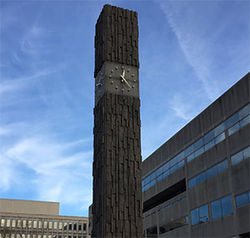
|
| Tour Henri-Capelltier, a landmark of the Université d'Outineau campus. |
With eight universities located in the metropolitan area, Outineau has one of the largest numbers of resident post-secondary students in Kelssek. It is home to two of Kelssek's most prestigious English and French universities - Desjardins and UniOut, respectively, which are also the province's two largest research institutions, as well as several component institutions of the Université du Beaulac system and its administrative headquarters. Several arts and science programs are offered at its campus north of Ville-Baptiste, known as UBAO (Université du Beaulac à Outineau).
The École de technologie supérieure (ETS), École nationale d'administration publique (ENAP), and Institut national de la recherche scientifique (INRS) form part of the Université du Beaulac system, while the highly reputed engineering and business programs of the École Polytechnique d'Outineau and the Hautes Études Commerciales d'Outineau (HECO) are affliated with the Université d'Outineau. Concorde University is a bilingual comprehensive university which teaches predominantly in English and has its campus in the downtown core.
The Outineau metropolitan area is also home to the Concervatoire du Kelssek, the country's oldest music school which offers degrees in music, and the Gillan Insitute of Fine Arts, a bilingual art and design university, is located in Dollard-des-Ormeaux. Université Dorval, a French-language humanities and theological university, is also located in Dorval.
Sports
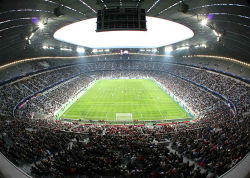
|
| With a capacity of over 80,000 Stade Outineau is the largest stadium in Kelssek. |
Hockey is by far the most popular sport in Outineau and CH Outineau, with more Desjardins Cup championships than any other KHL team, is as much a sports team as a symbol of the city itself. However, the Rugby Superleague's Nordiques are also very popular and have maintained an impressive record of selling out every home match since 2003.
Circuit Jacques Strappe, located on an artificial island in the delta just southeast of downtown Outineau, hosted the Grand Prix du Kelssek of the World Grand Prix Championship, which is Kelssek's largest motorsport event, and is the headquarters and main test track of the Revél-Celestar WGPC team. The circuit also hosts races in Kelssek's domestic motorcycle grand prix circuit.
Outineau hosted the 5th Summer Olympics, with the Stade Olympique d'Outineau serving as the Olympic stadium and centrepiece for the event. The final of the 46th World Cup was held at Stade Outineau; in a memorable final Dancougar beat Daehanjeiguk 5-4 in front of a full stadium of over 81,000 spectators. The stadium was built for the World Cup and afterwards became the home ground of the Nordiques rugby team. The stadium was also the venue for the 44th UICA Champions’ Cup final, won 4-2 by FC Axel Heiburg over Yuba United.
Professional sports teams
| Team name | Sport | League | Home venue |
|---|---|---|---|
| CH Outineau | Ice hockey | Kelssek Hockey League | Centre Belle |
| Nordiques Rugby | Rugby union | Rugby Superleague | Stade Outineau |
| Kraken d'Outineau | Water polo | Kelssek Water Polo League | Centre Saint-Hélène |
| Dollard-des-Ormeaux | Water polo | Kelssek Water Polo League | Complexe sportif DDO |
| Castors d'Outineau | Football | Kelssek Football League | Place Saint-Luc |
| CF Outineau | Football | Kelssek Football League | Parc de la Crémazie |
| Outineau Caribou | Lacrosse | National Lacrosse League | Centre Louis-Desjardins |
Sister cities
City twinning agreements exist with:
- Rêvane, Ariddia
- Septentrionalis, Septentrionia
